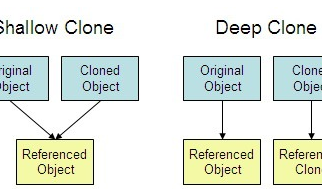The criminal justice system, and the disparities faced by African-Americans, have been central to the political debate for years. ?13th?, Ava DuVernay?s new documentary on the history of race and incarceration in the United States, could become a big part of that debate.
?13th? takes its title from the premise of a ?loophole? in the Thirteenth Amendment, with the premise that this allowed incarceration to simply re-enslave African-Americans under another name. This is an interesting idea, but the period immediately after the end of slavery is rushed through in about five minutes. A large portion of the movie is basically an engaging walk through a very standard narrative of mass incarceration. If you?ve read a bit about the subject, then you can probably recite the chapters of that narrative yourself: Jim Crow, the Civil Rights movement, backlash, Richard Nixon, the War On Drugs, Ronald Reagan, the crack/cocaine sentencing disparity, Bill Clinton, the Crime Bill, ?three strikes and you?re out?, etc.
Unfortunately, despite a lot of compelling primary source videos and some more original topics after the usual litany, I noticed a few statistics that are misleading, unclear, or incorrect. Some of these mistakes happen to hide things that would complicate the story ?13th? is trying to tell. Perhaps they make it a stronger piece of advocacy, but I think they make it a weaker piece of art.
1. Did Arrests Really ?Notch Up? After The Crime Bill?
For me, the most glaring factual issue in ?13th? came about forty minutes in. The subject was the crime bill signed by Bill Clinton in September of 1994. Writer Jelani Cobb is quoted as saying the following on the effects of the bill:

?And again we see this kind of notching up of the number of people who were being arrested at every level and this kind of exploding prison population.? Here?s estimated arrests from 1980?2012 from a Bureau Of Justice Statistics tool. Would you say that arrests ?notched up? in the aftermath of a bill signed in late 1994?

By 1998 ? just a few years after the crime bill ? there were fewer arrests than in 1994 when it was signed, and arrests have dropped further over time. These UCR estimates have almost 2.5 million fewer arrests for 2012 than for 1994. And frankly that graph is a generous one to use. Here?s arrests per capita:
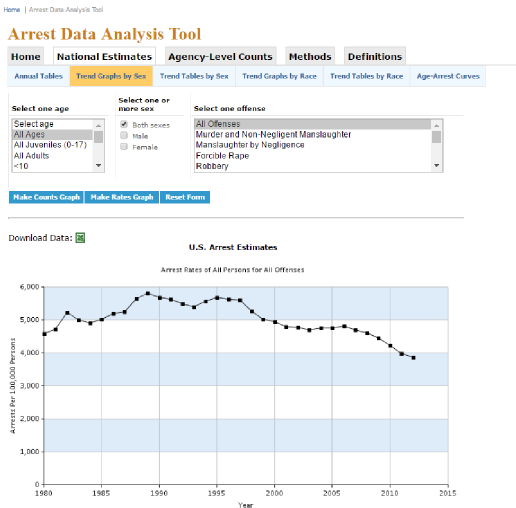
Far from ?notching up? in the aftermath of the crime bill, the arrest rate has been falling and is now much lower than it was in 1980, before much of ?mass incarceration?. Assuming these UCR estimates aren?t totally off, that means there have been millions and millions fewer arrests every year than if the rate had stayed where it was before the Crime Bill.
Perhaps there?s some way you can interpret Cobb?s statement so it?s literally true (was he only talking about the next year or two and ignoring everything else?) and I doubt anyone thinks the UCR estimates are perfect. Still, for the movie itself to imply that the 1990s saw an increase in arrests, and for that basically to be the last word on the subject, is misleading.
I can?t speak to why or how this is in ?13th? and it could have been a simple mistake, but correcting it might have been difficult within the movie?s narrative. It?s trying to argue that incarceration is part of a never-ending system of racial and social control. Acknowledging that estimated arrests per capita have been dropping, among African-Americans as well as overall, wouldn?t necessarily contradict that thesis but it might complicate it.
(Update: I should note that UCR ?arrests? include summons and citations. For graphs of UCR numbers limited to violent index crime, property index crime or drug abuse violations, use the tool linked above or see here ? all three trended down or flat soon after the Crime Bill, although for some reason drug violations had a brief spike from 2002 to 2006.)
2. Have Prison Populations Really Exploded Since?2010?
About ten minutes later, after an odd digression mostly into the life of Angela Davis, ?13th? concludes this section with its version of the prison population graph. You know the one: A chart showing how prison populations were pretty steady for decades and then had huge growth in the 1970s or 1980s. I have some issues with it, but it?s an iconic and effective examples of political data visualization. Here?s the one on Wikipedia, for example:
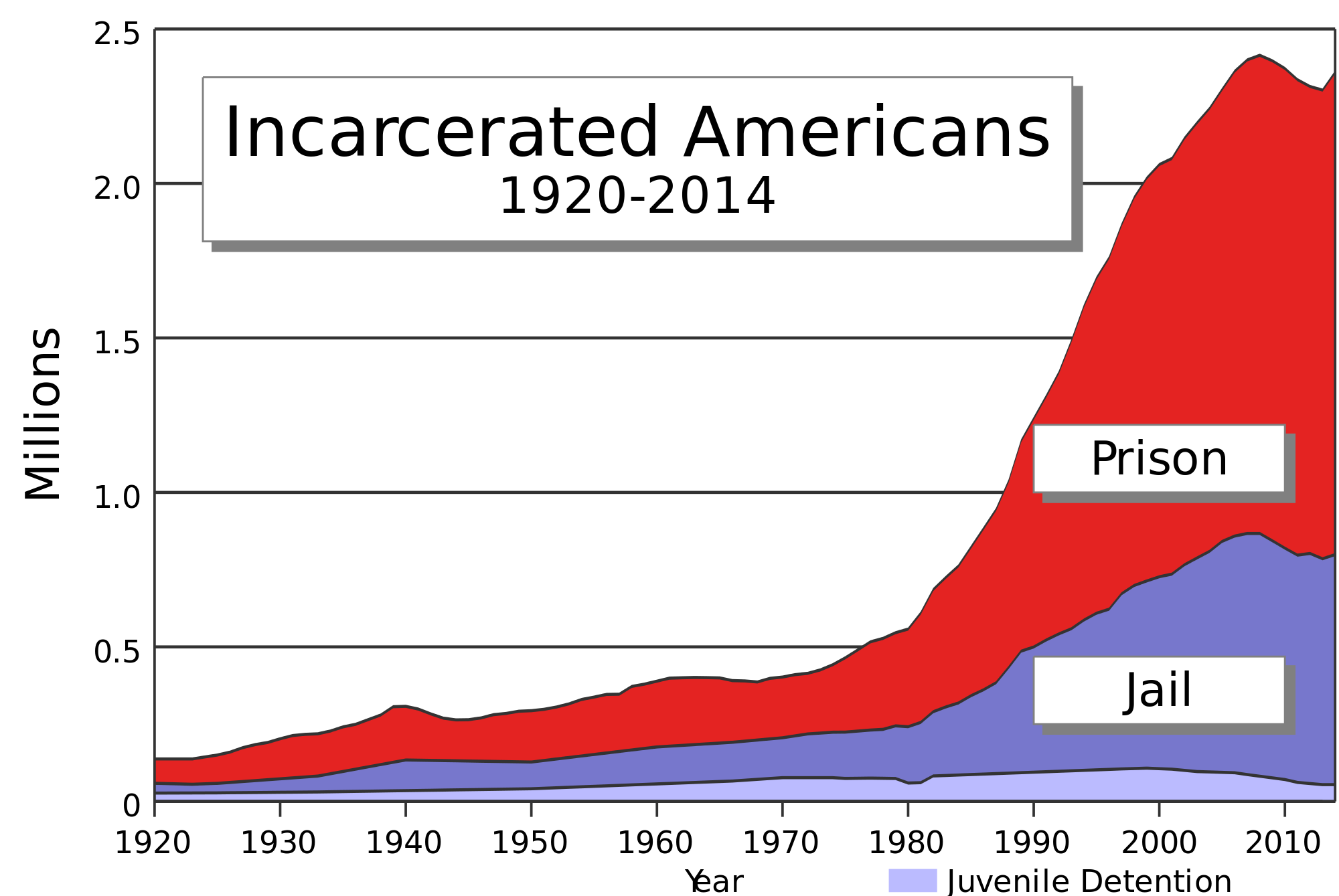
And here?s the one shown in ?13th?:

It looks like the usual graph, but?what the hell is that last dot? The one that suggests enormous prison population growth ? the fastest prison population growth ever, by a lot ? from 2010 to 2016? Is Wikipedia?s wrong?
First of all, I don?t know if any estimates of the 2016 prison population even exist. The year?s not over yet! As far as I know the most recent Bureau Of Justice Statistics estimates of prison and jail inmates are for 2014 ? not even for 2015 ? and far from another dramatic explosion, they show prison and jail populations lower in 2014 than in 2010.
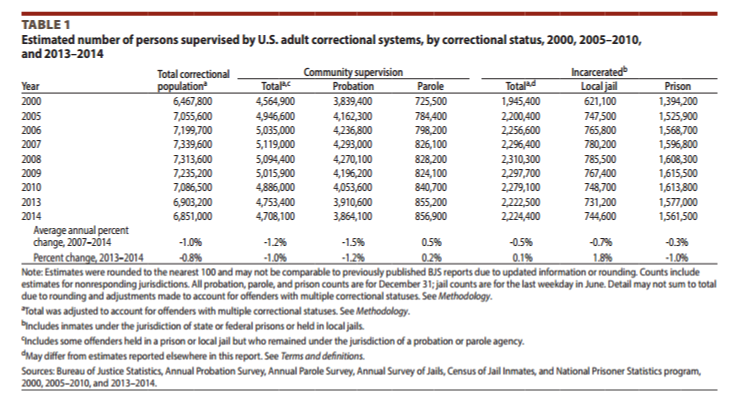
Go over to the part that says ?incarcerated?. In this table, the total incarcerated population is given as 2,279,100 for 2010 and 2,224,400 for 2014 ? again, a decrease rather than the huge increase shown in the movie?s chart. [1]
This is a very strange mistake; the turn from ever-increasing prisons has been widely discussed. ?13th? itself has people discussing a policy shift away from incarceration later in the documentary, albeit in a sometimes conspiratorial way (at about an hour and 19 minutes in, Angela Davis says ?historically, when one looks at efforts to create reforms, they inevitably lead to more repression??inevitably?). Again, I?m not sure what explains this odd graph. It might just be a visual typo, but I think that the effect is considerably misleading, and that an accurate graph might sit uneasily with quotes like Davis?.
3. Are Black Men Really (Still) 40.2% Of The Prison Population?
An hour and twenty minutes into ?13th?, they make a familiar point about racial disparity: onscreen graphics say that Black men are 6.5% of the population but 40.2% of the prison population.
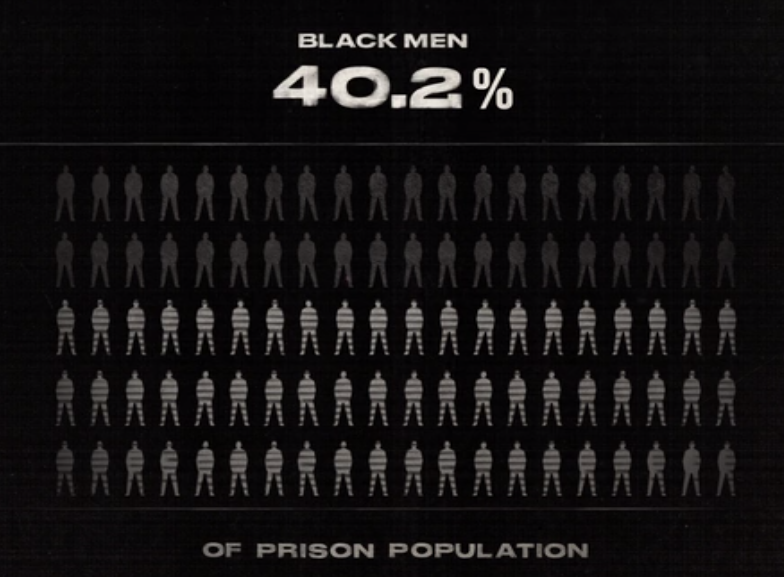
Combining racial and gender disparities in incarceration has odd implications that I?m not sure the filmmakers realize (White men are about 30% of the population and maybe 33% of the prison population, Black and Hispanic women are something like 15% or 16% of the population and maybe 4% of the prison population, does that mean Black and Hispanic women are treated more leniently than White men?).
But beyond that: Here are the end-of-year BJS prison population numbers and the mid-year BJS jail population numbers for 2014:
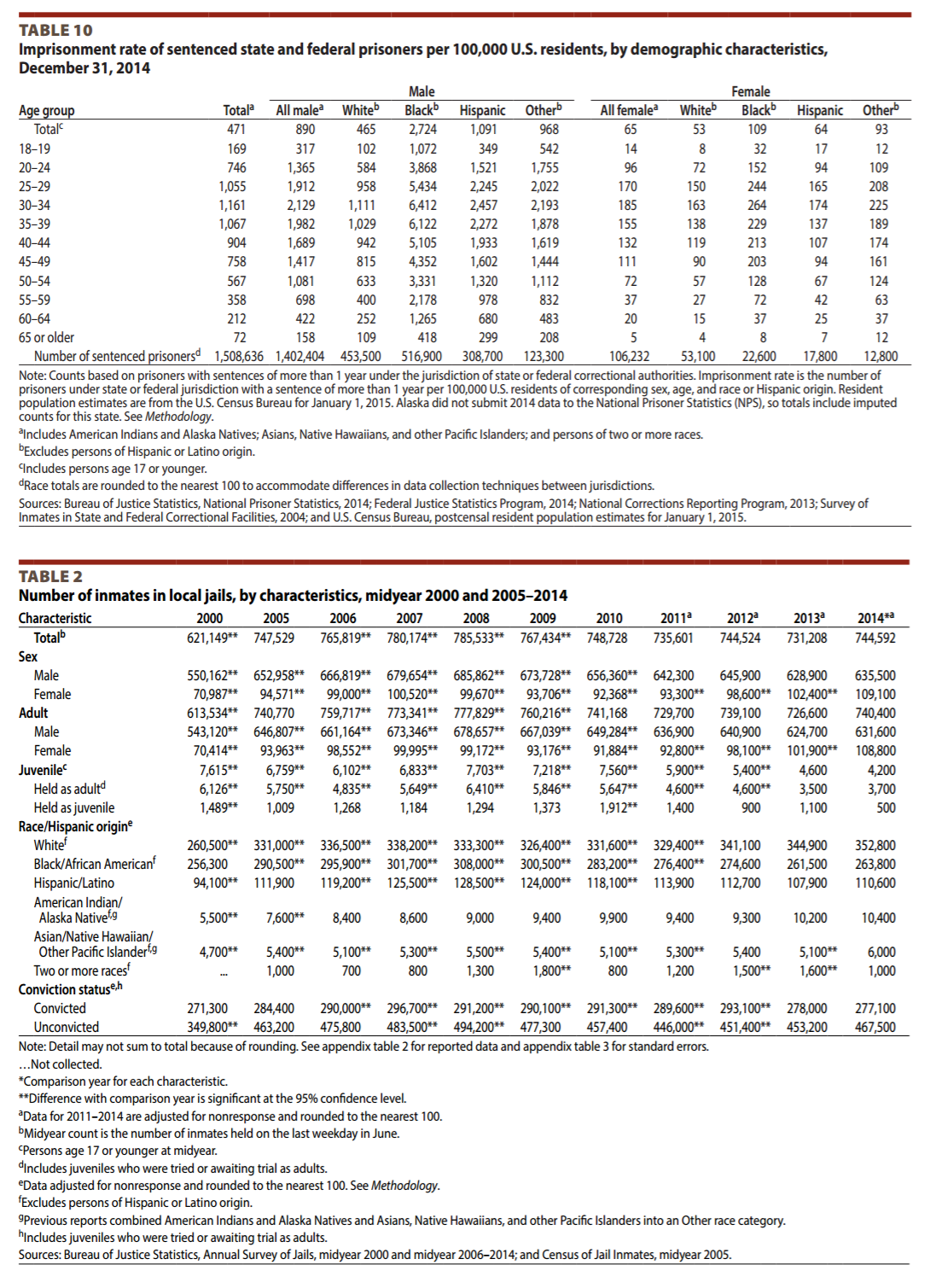 1
1
Ignoring the issues with double-counting (about 80,000 people are counted for both prisons and jails and the definitions are also a bit different from the above table), the African-American prison and jail population would be 516900+22600+263800=803,300; the total prison and jail population would be 1508636+744592=2,253,228. That suggests that African-Americans ? men and women ? are more like 803300/2253228 = 35.7% of the prison/jail population; so African-American men are perhaps more like 33% of the prison/jail population than 40%. Of course, that is still a very disproportionate number.
Double-counting issues aside, I can?t find a source for the ?Black men are 40.2% of the prison population? figure. Googling suggests that it?s been cited as a statistic for 2008 as long ago as 2011 (sometimes in articles discussing ?The New Jim Crow? author Michelle Alexander, who is heavily featured in ?13th?, but I?m not sure she?s ever said it herself). I don?t know if it was true for 2008 but it has probably been true at some point.
In fact larger numbers have probably been true at some point: African-Americans were around 45% of the prison/jail population in 2000. But this isn?t just a nitpick about a small difference. To keep repeating that Black men are 40.2% of the prison population, year after year, is to miss one of the biggest demographic trends in incarceration: It is getting less Black and more White and/or more Hispanic (depending on how you account for changing demographics in the total population), more rural and less urban, even as racial disparities remain enormous:
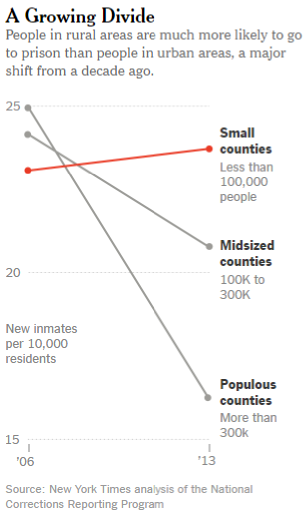 Graphic by Josh Keller, Adam Pearce, and John Pfaff from linked NYT article.
Graphic by Josh Keller, Adam Pearce, and John Pfaff from linked NYT article.
As for the racial trends: The White male state/federal prison incarceration rate per 100,000 rose from 449 in 2000 to 465 in 2014 as the White female rate rose from 34 to 53; the Black male state/federal prison incarceration rate dropped from 3457 to 2724 as the Black female rate dropped from 205 to 109. (The Hispanic male state/federal incarceration rate actually dropped from 1220 to 1091 while the Hispanic female state/federal incarceration rate rose slightly from 60 to 64, but Hispanics generally seem to have risen as a share of the incarcerated ? Whites may not have ? and there was more absolute growth in Hispanic state/federal prisoners than in White state/federal prisoners.) There were 7,500 more estimated African-American local jail inmates in 2014 than in 2000, possibly not even a statistically significant difference, 16,500 more estimated Hispanic inmates ? and 92,300 more estimated White inmates. I?d have liked to see ?13th? acknowledge that.
Glossing Over Basic Facts To Fit A Narrative.
These three factual issues gloss over that arrest rates have dropped enormously, that incarcerated populations have slightly declined, and that incarceration has gotten more Hispanic and/or White ? three of the more important current trends in incarceration. Again, none of those things exactly contradicts the theme of ?13th?, but admitting them might have required a more nuanced and complicated film. Instead, whatever the intent, they seem glossed over.
I?ll repeat myself: Racial disparities have been and remain enormous. But an honest and relevant look at the criminal justice system in 2014 might tell that story along with the stories of strongly punitive, often mostly White and rural counties (which themselves can be even more enormously punitive to their few minorities). It might mention that New York?s state prison incarceration rate peaked nearly twenty years ago ? a decline driven in part by enormous reductions in New York City drug admissions ? or that Miami-Dade county has 13% of Florida?s population but committed just 8% of its state inmates in FY 2014?2015.
?13th? doesn?t mention any of that. With the exception of a welcome segment on immigration, Hispanic and Latino inmates are mostly referenced only glancingly, usually lumped into ?people of color? without discussion of particular issues or history. I?m not sure a single white person is explicitly acknowledged to be in the criminal justice system (I think the main allusion is towards the end: Michelle Alexander says mass incarceration ?is gobbling up people in communities of all colors? but this is only possible because ?it began with a group of people defined by race?[2]). The documentary makes a very valid point that African-Americans can be over-represented in the media as criminals, but it falls into the same trap itself: African-Americans are about 36% of the incarcerated population but just about 100% of its representation and discussion of incarceration; non-Hispanic whites are about 38% of the incarcerated population but just about 0% of its discussion.
The experience of African-Americans under mass incarceration is certainly a valid subject for a documentary, but ?13th? keeps talking about the whole prison population. Correct statistics and representative examples would still show inequality, but they would probably underline the weakness of the central metaphor: Slavery and Jim Crow were not simply racially disparate, they were more like racially absolute. The ?slavery rate? of 1860 wasn?t just much higher for African-Americans than for Whites; 89% of African-Americans were slaves compared to 0% of Whites. Incarcerated populations as a whole are indeed majority non-White, but that?s not true everywhere. As of 2015 or 2016, Arkansas state prisons are 54% White, Oklahoma state prisons are 54.5% White, Tennessee state prisons are 55.3% White, Kentucky state prisons are 76% White. That?s disproportionate to population in every case, but to say the very least, there was never a Southern state where a majority of the slaves were White, or where a majority of those facing Jim Crow laws were White.
DuVernay?s ?13th? obviously isn?t trying to be a neutral depiction of the criminal justice system ? as if that were even possible ? but to make a case against it, and perhaps for the abolition of prison itself. (At least that?s in the discussion around the movie; that argument isn?t made directly in the movie itself.) Documentaries and art will always have a point of view but will also risk glossing over facts that don?t fit. I suspect the strongest cases stand up well even if you include as much as possible.
I have some additional thoughts about the rest of ?13th?, but those might be in a follow-up piece.
[1] I?m not sure exactly how ?13th? is defining ?prison population?; an onscreen graphic shows the 2000 prison population as 2,015,300, which is what you get from adding the state and federal prison and local jail populations in the first table without factoring in double-counting. The Prison Policy Institute?s broad definition includes about 90,000 people outside of state and federal prisons and local jails, but that isn?t going to explain much.
[2] Alexander?s exact quote, at about an hour and thirty-five minutes:
?The system of mass incarceration has grown, and sprawled and developed an appetite that is gobbling up people in communities of all colors. But if it hadn?t been for the fact that it began with a group of people defined by race, that we as a nation have learned not to care about, we wouldn?t be talking about two million people behind bars today.
[3] Full disclosure: I have not read ?The New Jim Crow?, but I have read James Forman Jr.?s rebuttal ?Racial Critiques Of Mass Incarceration: Beyond The New Jim Crow?, which I think makes some similar points as I make here, especially in my last few paragraphs.
Note: I changed the title from ?Ava DuVernay?s ?13th? And Documentary As Advocacy: Some Factual Issues.? on 10/12/2016 at 2:42 pm.
I also added some clarification on ?arrests? on 10/14/2016 at 5:02 pm.


